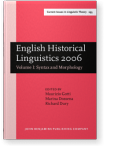'Tis he, 'tis she, 'tis me, 'tis – I don't know who … cleft and identificational constructions in 16th to 18th century English plays
It is generally assumed that the construction It is me emerged in the 16th century as the more colloquial alternative to It is I. In this paper, we focus on the structure and distribution of two constructions featuring It is I/me, namely cleft constructions (ClCs) and identificational copular clauses (IdCCs) in plays from 1600 to 1800. Surprisingly, it turns out that it is I or rather ‘tis I is the general rule; the very limited occurrences of me in the relevant constructions are either licensed by the syntactic context in ClCs or by referential conditions in IdCCs. We further provide evidence for the assumption that IdCCs are historically prior to ClCs, which in turn are not fully grammaticalized in the period under discussion since they do not unambiguously display the biclausal structure which is a defining property of clefts.
